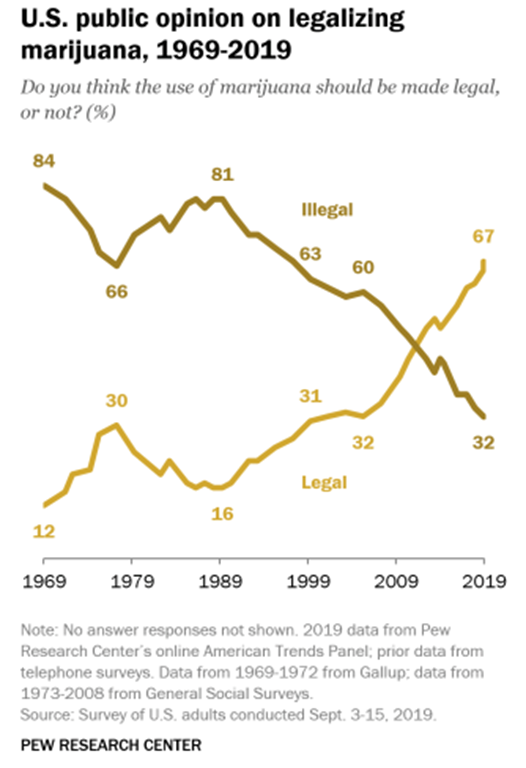
We propose the gradual phasing out of the medical marijuana system in favor of one class of marijuana.
Throughout much of the 20th Century, marijuana had a stigma attached to it. A lot of this stigma arose from the 1936 film, Reefer Madness, which gave a rather melodramatic account of what happens when one uses marijuana. But marijuana’s use amongst the counterculture movement of the late-1960s also contributed to this stigma. Combine the influence of Reefer Madness and the association of marijuana with “hippies” with the government’s classification of marijuana as a Schedule I substance, and public perception of marijuana was quite negative as it was often viewed as high-risk and a “gateway drug”. But that is no longer the case.
The Winds of Change – From Malevolent to Benevolent
Those perceptions are now antiquated. As the following chart from the Pew Research Center shows, U.S. public opinion on the legalization of marijuana has flipped over the last 50 years showing that the association of marijuana with Reefer Madness and the dangerous counterculture has washed away (Daniller 2019).
Part of the switch in public opinion is related to how risky and harmful people now see marijuana. As marijuana has become more ubiquitous, thanks to the legalization of it in many states for both medicinal and recreational purposes, the percentage of people who perceive marijuana to be high risk has decreased since 2002 (41.6% to 26.1%) while the percentage of people who perceive it to be low risk has increased (16.8% to 35.8%) (Levy, et al. 2021). Of course, this trend is not necessarily related to the potency of marijuana or the actual risk factors, or harm associated with its use.

In reality, it is more likely related to the continued increase in the legalization of marijuana in the majority of states around the country. As states have given marijuana a seal of approval, public perception has subsequently adjusted. According to a separate Pew Research Center study from 2021, 91% of Americans now believe marijuana should be legal for either medicinal and recreational use or just medicinal use (van Green 2021). There are divergences in the data with older Americans less supportive of legalizing marijuana, not surprisingly, but as that generation dies off, public perception of marijuana will continue to remain favorable.
Confluence of Speed and Lack of Critical Information
These changes in public perception are influencing policymakers and contributing to the fast pace of legalization across the country. While most view this as a positive development, there are critical issues with the movement and the speed at which it is finding success.
Simultaneous with the increase in recreational drug use and the spread of legalization, there has been a “steady erosion in the public perception of the harms associated with the use of popular drugs…” (Weiss, Howlett and Baler 2017).
As the legalization of marijuana has continued apace, especially on the medicinal front, the issues previously discussed are proving to be more problematic. The research is not there to adequately link marijuana to positive health benefits. There are too many unknowns. Laws are currently being written and rewritten without a commitment to developing these laws based on science and research to highlight potential issues. Much of these declining perceptions have the effect of overemphasizing the benefits while reducing concern about the downsides.
For example, one area in which there is a huge knowledge gap is related to THC potency and its impact on health. The average concentration of THC has increased from around 3% in the 1980s to 12% or more recently. Of course, that concentration is only from research into marijuana seized by the U.S. Drug Enforcement Agency and does not include research into products currently being sold in dispensaries around the country, which purportedly include products with THC concentrations exceeding 70%.
“The effects of such high levels of THC exposure on the brain are unexplored, and may be particularly hazardous for young users…” (Weiss, Howlett and Baler 2017). To continue to link recreational and medicinal marijuana without understanding the effects of such high levels of THC is dangerous.
The intensifying concentration of THC is just one concerning aspect of the proliferation of marijuana throughout the country and how proliferation is affecting our perceptions of risk. It is possible while the perceptions of the riskiness of marijuana crater, the actual risk associated with the product is increasing. The only way to determine whether this is actually true and what health risks currently exist is by encouraging more in-depth research into the marijuana products Americans are using for both recreational and medicinal purposes.
Myths about Marijuana’s Physically and Psychologically Addictive Properties
Unfortunately, another problem with the confluence of medicinal and recreational marijuana use are the myths associated with marijuana and how it impacts its users. Marijuana is often viewed as only providing positive benefits, especially when compared with other Schedule I drugs like heroin, bath salts, ecstasy, and quaaludes. But this conventional wisdom ignores scientific and important anecdotal evidence about the risk of marijuana use, both physical and psychological.
We propose the gradual phasing out of the medical marijuana system in favor of one class of marijuana.

Michael M. Michaud
Contributing Author, Public Policy
Public policy and communications professional with a focus on the intersection of public policy and business.
About Weedless.org
Weedless.org is a free, web-based resource and community created by a team of healthcare professionals and researchers. We distill the facts about marijuana use and its effects into practical guidance for interested persons or for those who are thinking about or struggling to quit weed. Finding reliable, easy to understand information about marijuana should never be a struggle—that is why our core mission is to provide the most up to date information about marijuana use, abuse, addiction, and withdrawal. While we seek to empower individuals to have control over their use, we are not “anti-weed” and we support efforts to legalize adult marijuana use and study.
People should be informed on the benefits of marijuana specially today, with all the technological advances that enabled the plant to be more beneficial.